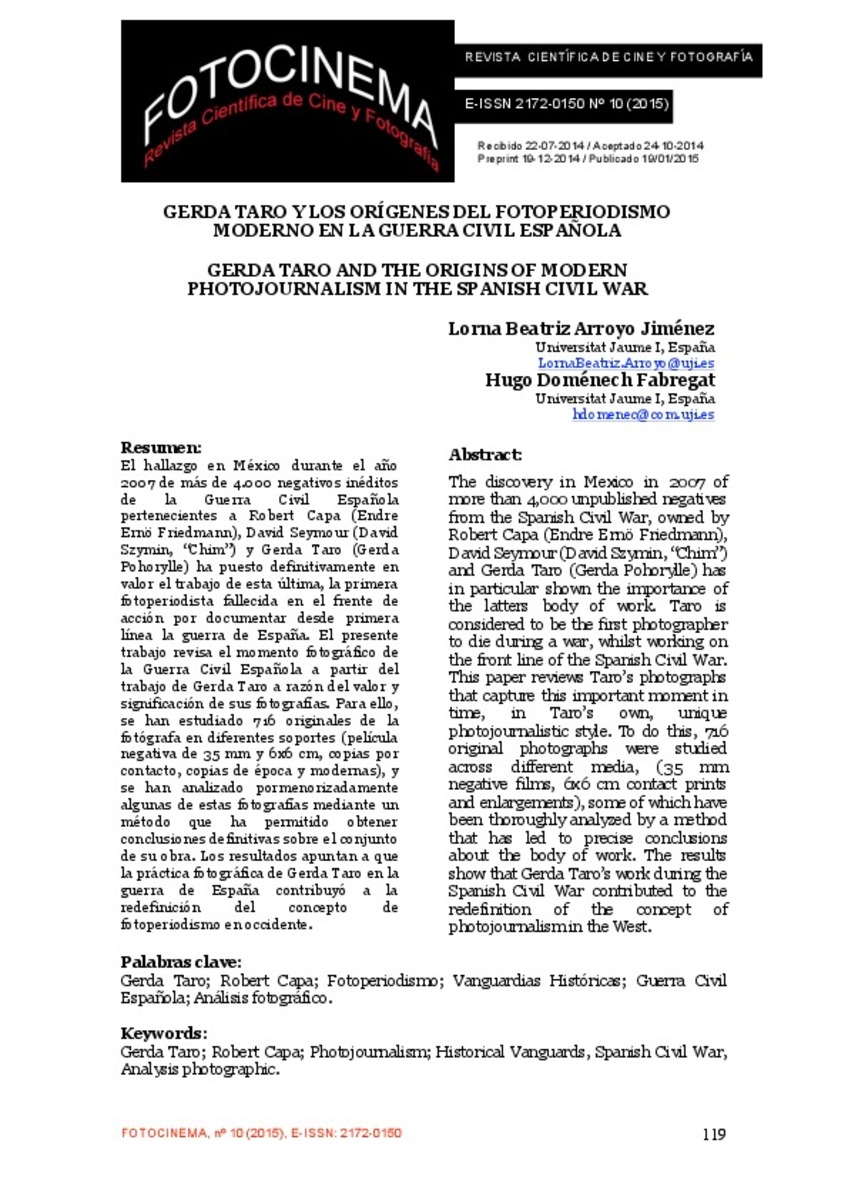Mostrar el registro sencillo del ítem
Gerda Taro y los orígenes del fotoperiodismo moderno en la Guerra Civil española
| dc.contributor.author | Arroyo Jiménez, Lorna Beatriz | |
| dc.contributor.author | Doménech-Fabregat, Hugo | |
| dc.date.accessioned | 2016-04-21T14:44:55Z | |
| dc.date.available | 2016-04-21T14:44:55Z | |
| dc.date.issued | 2015 | |
| dc.identifier.citation | Arroyo, L.B. y Doménech, H. (2015). “Gerda Taro y los orígenes del fotoperiodismo moderno en la Guerra Civil española”. Fotocinema. Revista científica de cine y fotografía, 10, pp. 119-153. Disponible: http://www.revistafotocinema.com/index.php?journal=fotocinema&page=article&op =view&path[]=282 | ca_CA |
| dc.identifier.issn | 2172-0150 | |
| dc.identifier.uri | http://hdl.handle.net/10234/158909 | |
| dc.description.abstract | El hallazgo en México durante el año 2007 de más de 4.000 negativos inéditos de la Guerra Civil Española pertenecientes a Robert Capa (Endre Ernö Friedmann), David Seymour (David Szymin, “Chim”) y Gerda Taro (Gerda Pohorylle) ha puesto definitivamente en valor el trabajo de esta última, la primera fotoperiodista fallecida en el frente de acción por documentar desde primera línea la guerra de España. El presente trabajo revisa el momento fotográfico de la Guerra Civil Española a partir del trabajo de Gerda Taro a razón del valor y significación de sus fotografías. Para ello, se han estudiado 716 originales de la fotógrafa en diferentes soportes (película negativa de 35 mm y 6x6 cm, copias por contacto, copias de época y modernas), y se han analizado pormenorizadamente algunas de estas fotografías mediante un método que ha permitido obtener conclusiones definitivas sobre el conjunto de su obra. Los resultados apuntan a que la práctica fotográfica de Gerda Taro en la guerra de España contribuyó a la redefinición del concepto de fotoperiodismo en occidente. | ca_CA |
| dc.description.abstract | The discovery in Mexico in 2007 of more than 4,000 unpublished negatives from the Spanish Civil War, owned by Robert Capa (Endre Ernö Friedmann), David Seymour (David Szymin, “Chim”) and Gerda Taro (Gerda Pohorylle) has in particular shown the importance of the latters body of work. Taro is considered to be the first photographer to die during a war, whilst working on the front line of the Spanish Civil War. This paper reviews Taro’s photographs that capture this important moment in time, in Taro’s own, unique photojournalistic style. To do this, 716 original photographs were studied across different media, (35 mm negative films, 6x6 cm contact prints and enlargements), some of which have been thoroughly analyzed by a method that has led to precise conclusions about the body of work. The results show that Gerda Taro’s work during the Spanish Civil War contributed to the redefinition of the concept of photojournalism in the West. | ca_CA |
| dc.format.extent | 35 p. | ca_CA |
| dc.format.mimetype | application/pdf | ca_CA |
| dc.language.iso | spa | ca_CA |
| dc.publisher | Universidad de Málaga | ca_CA |
| dc.relation.isPartOf | FOTOCINEMA, nº 10 (2015), E-ISSN: 2172-0150 | ca_CA |
| dc.rights.uri | http://rightsstatements.org/vocab/CNE/1.0/ | * |
| dc.subject | Gerda Taro | ca_CA |
| dc.subject | Robert Capa | ca_CA |
| dc.subject | Fotoperiodismo | ca_CA |
| dc.subject | Vanguardias Históricas | ca_CA |
| dc.subject | Guerra Civil Española | ca_CA |
| dc.subject | Análisis fotográfico | ca_CA |
| dc.subject | Photojournalism | ca_CA |
| dc.subject | Historical Vanguards | ca_CA |
| dc.subject | Spanish Civil War | ca_CA |
| dc.subject | Analysis photographic | ca_CA |
| dc.title | Gerda Taro y los orígenes del fotoperiodismo moderno en la Guerra Civil española | ca_CA |
| dc.type | info:eu-repo/semantics/article | ca_CA |
| dc.rights.accessRights | info:eu-repo/semantics/openAccess | ca_CA |
| dc.relation.publisherVersion | http://www.revistafotocinema.com/index.php?journal=fotocinema&page=article&op=view&path%5B%5D=301 | ca_CA |
Ficheros en el ítem
Este ítem aparece en la(s) siguiente(s) colección(ones)
-
COM_Articles [810]







